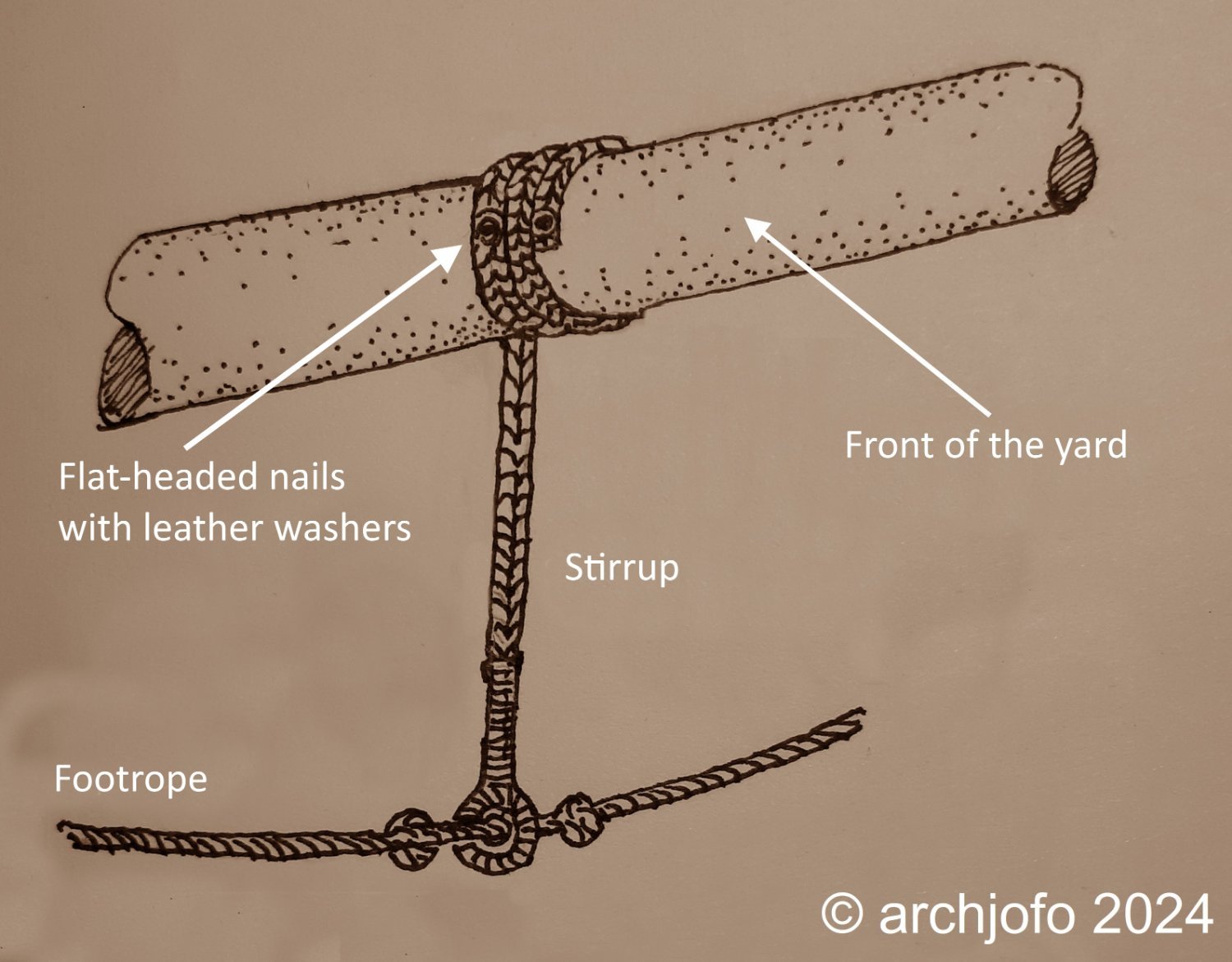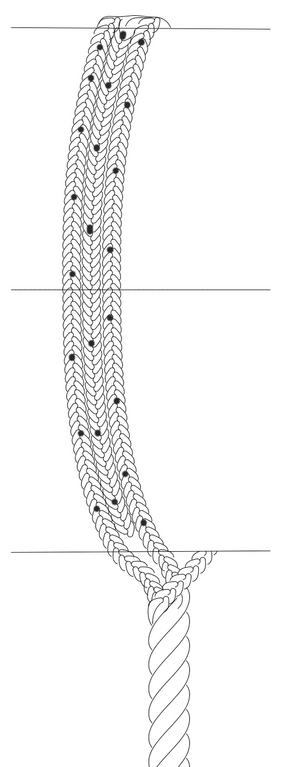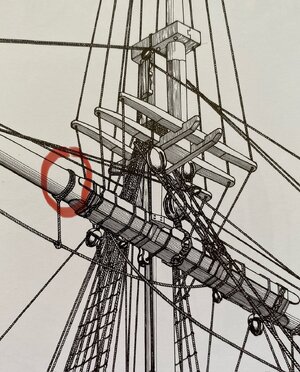You are using an out of date browser. It may not display this or other websites correctly.
You should upgrade or use an alternative browser.
You should upgrade or use an alternative browser.
- Joined
- Aug 8, 2019
- Messages
- 4,127
- Points
- 688

Go here, @archjofo explains it a little. These stirrups are nailed. I didn't know this before but learned from him.
Maybe his log is a help for you to
Maybe his log is a help for you to
La Créole 1827 by archjofo - Scale 1/48 - French corvette
Good morning Johann quick question about the above book title, is this the right book? That's the correct one. It is also for free download. here is the LINK
shipsofscale.com
I'm doing the same thing. The stirrups were wrapped three times around the yard and nailed. If your really want to feel inept look here

 modelshipworld.com
modelshipworld.com

La Créole 1827 by archjofo - Scale 1/48 - French corvette
 modelshipworld.com
modelshipworld.com
We were typing at the same time
Oops, my link takes you to MSW. Use Steef's link
Oops, my link takes you to MSW. Use Steef's link
Last edited:
And I don't think they were at 6 o'clock. I think they were wrapped and hung down on the aft side of the yard. That way when the men were standing on them they could stand up straighter than if the stirrups hung from the 6 o'clock position. Let me know if I'm wrong as I haven't done them yet. Still fighting with those fiddly cleats. They stick to your fingers better than they stick to the yard 
This all starts to make sense to me. Strange, the picture I presented in my first post clearly shows a stirrup at 6 o'clock to yard. This apparently is wrong.And I don't think they were at 6 o'clock. I think they were wrapped and hung down on the aft side of the yard. That way when the men were standing on them they could stand up straighter than if the stirrups hung from the 6 o'clock position.
I noticed that and thought maybe it was just the drawing was funny but I think you're right, they are shown hanging from 6. Is the drawing a different era, country? Any pictures I've looked at show it hanging from one side.
This is from book HMS VICTORY by MCGOWAN.
Lees doesn't say much more than they were wrapped 3 times and nailed and Longridge doesn't say that much. Because the Victory has been around so long and rebuilt so many times I would think you'd have to be careful which era you were researching.
Last edited:
From Steel.
HORSES go over the yard-arms with an eye in their outer ends, and stop against the cleats, and hang about three feet below the yard. To keep the horse more parallel to the yard, it is suspended, at proper distances, by ropes, called stirrups, that have thimbles or eyes spliced in their lower ends, through which the horses pass; they are four on each side, and hang three feet below the yard, and the upper ends are opened, plaited, and fastened to the yard with three round turns and nails. The inner ends of the horses have a thimble turned in, with a throat and round seizing; they lash to the yard, on the opposite side of the cleats, with a laniard that passes round the yard and through the thimble.

HORSES go over the yard-arms with an eye in their outer ends, and stop against the cleats, and hang about three feet below the yard. To keep the horse more parallel to the yard, it is suspended, at proper distances, by ropes, called stirrups, that have thimbles or eyes spliced in their lower ends, through which the horses pass; they are four on each side, and hang three feet below the yard, and the upper ends are opened, plaited, and fastened to the yard with three round turns and nails. The inner ends of the horses have a thimble turned in, with a throat and round seizing; they lash to the yard, on the opposite side of the cleats, with a laniard that passes round the yard and through the thimble.

That's an interesting picture. That looks like the rope is separated into the three strands and then each strand is separated into three strands and then braided(plaited). I assumed that it would be separated into the first three strands and then braided into one braid and that is wrapped around the yard three times. Is that your picture or Steel's?
That is my interpretation of Steel's description. Each of the 3 strands separated and the yarns of each strand plaited and 1 full turn of the yard gives the 3 full turns nailed to the yard.
Sorry. "Plaited" would mean braided as with long human's hair?plaited
Yes YT Plaited or Braided is the same thing. Both Steel and Lever refer to it a Plaited. Pronounced platted these days.
correctGo here, @archjofo explains it a little. These stirrups are nailed. I didn't know this before but learned from him.
Maybe his log is a help for you to
La Créole 1827 by archjofo - Scale 1/48 - French corvette
Good morning Johann quick question about the above book title, is this the right book? That's the correct one. It is also for free download. here is the LINKshipsofscale.com
We're going to have to disagree on this but after sleeping on it I can definitely see how you arrived at that way. I won't be using either method on the Discovery. Too fiddley for my old hands. Unwrapping and braiding a .016" line? Not likelyThat is my interpretation of Steel's description. Each of the 3 strands separated and the yarns of each strand plaited and 1 full turn of the yard gives the 3 full turns nailed to the yard.
I also just noticed that you said four stirrups on either side. All the Swan series and some others of the same era that I have been using as examples show three. But I default to Steel so four it is. I'll have to cut off and redo the horses but they were a bit short anyway. Thanks for bringing that to my attentionFrom Steel.
HORSES go over the yard-arms with an eye in their outer ends, and stop against the cleats, and hang about three feet below the yard. To keep the horse more parallel to the yard, it is suspended, at proper distances, by ropes, called stirrups, that have thimbles or eyes spliced in their lower ends, through which the horses pass; they are four on each side, and hang three feet below the yard, and the upper ends are opened, plaited, and fastened to the yard with three round turns and nails. The inner ends of the horses have a thimble turned in, with a throat and round seizing; they lash to the yard, on the opposite side of the cleats, with a laniard that passes round the yard and through the thimble.
Kurt Konrath
Kurt Konrath
As for the question of are they hanging at 6 o'clock from the yards, I say most drawings I have seen say yes, that is for the support loops that are in between the ends, which may be on the side but gravity will take the hanging stirrup rope straight down when weight of the sailor is applied a time or two.
careful with that one Don. The quote from Steel is for the lower yards. There are fewer stirrips on smaller yards. On Discovery's lower yards 3 is probably correct.I also just noticed that you said four stirrups on either side. All the Swan series and some others of the same era that I have been using as examples show three. But I default to Steel so four it is. I'll have to cut off and redo the horses but they were a bit short anyway. Thanks for bringing that to my attention
I'm looking at Steels "Table of the Quantities and Dimensions of the Standing and Running Rigging"

This is for a 14 to16 gun 300 ton sloop. He says Horses 2 and then Stirrups 4. I thought this coincided with your 4 per side but maybe this is for the whole mast so 2 per side. That said if i go to the biggest ship 2200 ton he only lists 6 stirrups on the main yard which would be 3 per side which everyone seems to use. So where is the four per side that he talks about. I know I'm down a rabbit hole here and it ain't that important but hey, it's part of the hobby. Maybe I'll stay with 3 per side so I don't have all the 3 per side people saying I have to many stirrups.
Way to fold, Don

PS Steel list ships of 280 to 300 tons with 4 stirrups. The next largest is 400 to 450. 500 to 450 ton ships have 6 stirrups. Discovery is 330 ton. Right in the middle. I've often wondered if, because she was going on a long trip, maybe they over rigged her. I've been using the 280 to 300 specs. I'll have to lean more to the 400 to 450 specs maybe. I'm going with 6. Now I can crawl out of this rabbit hole.

This is for a 14 to16 gun 300 ton sloop. He says Horses 2 and then Stirrups 4. I thought this coincided with your 4 per side but maybe this is for the whole mast so 2 per side. That said if i go to the biggest ship 2200 ton he only lists 6 stirrups on the main yard which would be 3 per side which everyone seems to use. So where is the four per side that he talks about. I know I'm down a rabbit hole here and it ain't that important but hey, it's part of the hobby. Maybe I'll stay with 3 per side so I don't have all the 3 per side people saying I have to many stirrups.
Way to fold, Don
PS Steel list ships of 280 to 300 tons with 4 stirrups. The next largest is 400 to 450. 500 to 450 ton ships have 6 stirrups. Discovery is 330 ton. Right in the middle. I've often wondered if, because she was going on a long trip, maybe they over rigged her. I've been using the 280 to 300 specs. I'll have to lean more to the 400 to 450 specs maybe. I'm going with 6. Now I can crawl out of this rabbit hole.
Last edited:



